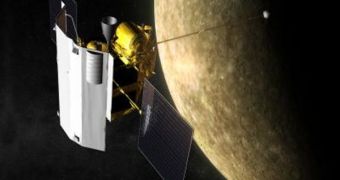NASA's MErcury Surface, Space ENvironment, GEochemistry and Ranging (MESSENGER) probe is scheduled to begin its third and final flyby of the closest planet to the Sun today, before pulling a complex, gravity-assist maneuver that will allow for it to be captured in the planet's orbit starting with March 2011. Traveling at more than 100,000 miles per hour, the spacecraft will fly at less than 142 miles above the surface of Mercury, and will image the portions that were left unchecked during the previous two flights. The probe, launched in 2004, will travel about 4.9 billion miles in its journey.
“We will be pointing at each individual target from several different angles during the flyby, which will allow us to collect more data. One of the big questions planetary scientist have is how much iron there is on Mercury's surface. We hope to pinpoint the iron, determine what chemical form it is in and how it is bound up on the planet's surface,” University of Colorado in Boulder (UCB) senior research associate William McClintock explains. He holds an appointment at the university's Laboratory for Atmospheric and Space Physics, and he is also a co-investigator for the MESSENGER mission.
McClintock is part of the UCB science team that worked on designing the Mercury Atmospheric and Surface Composition Spectrometer, or MASCS, instrument aboard the space probe. The craft features a grand total of four spectrometers, a camera, a magnetometer, and an altimeter. During today's flyby, the MASCS instrument will be used to photograph targets of interest, identified during the previous passes, including some unusual surface deposits and craters. Detecting traces of iron is very important, as the metal determines important traits of Mercury's magnetic field.
“During this third encounter, the MESSENGER camera will again image areas never before seen at close range, and we will obtain color images of other regions at resolutions superior to those of previous observations,” Carnegie Institution in Washington expert Sean Solomon, who is also the principal investigator of the MESSENGER mission, adds.
“The hands-on space education and training opportunities offered to students at LASP in science, engineering and mission operations is available at few other places in the world. CU-Boulder undergraduates and graduate students are involved in virtually all of our space efforts, from designing and building flight instruments to controlling satellites from campus, which makes for a profound educational experience,” co-investigator Daniel Baker, the director of the Laboratory for Atmospheric and Space Physics, shares.

 14 DAY TRIAL //
14 DAY TRIAL //